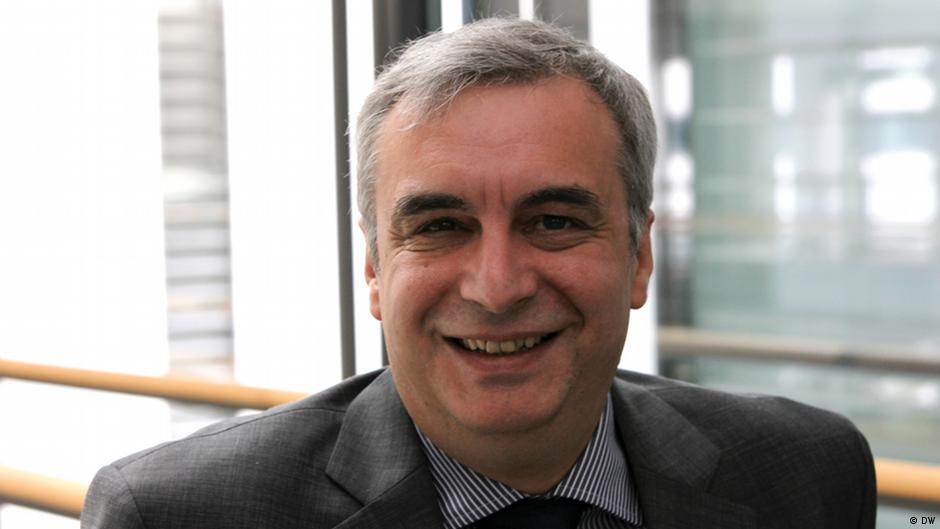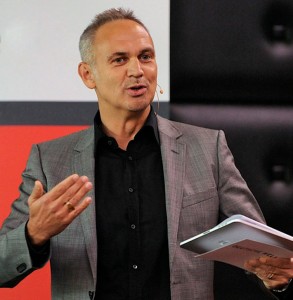News anchors away: Stewart, Williams and the news about the news
Brent Goff, DW News Main Anchor
This was not the way I planned to start the day. In fact, I got very little sleep last night after I heard the news. The news about the news. The news about what the news just lost — times two. In the span of less than an hour, the two most (still) trusted and recognized television news anchors in the United States announced that they are leaving.
When I heard the news alarm on my iPhone and read the headline “Most trusted journalist is hanging it up”, I immediately assumed this was the career benediction for NBC’s “misremember” main anchor, Brian Williams. But I was jolted out of my sleep when I realized the headline referred to the host of The Daily Show, Jon Stewart.
My instinct — to associate “most trusted journalist” with a major news operation such as NBC — was right and yet oh so wrong. Not immediately including a faux-news anchorman in my calculus of highest trust seemed normal, but it does not compute in the new normal.
And then it hit me: We journalists live and operate in two realities. One, in which we like to see ourselves. The other, in which the world perceives us. The two are disturbingly different.
NBC’s announcement that “Nightly News” Anchor Brian Williams will take a six-month leave without pay in the wake of “Misremember-Gate” received cynical eyebrow-raising reactions on social media. Six months? Is that long enough? What happens after six months? Will we forgive and forget and allow Williams to reassume his news throne?
When the flash came that Jon Stewart is leaving The Daily Show, it felt like a modern day version of “Sinners in the Hands of an Angry God”. A collective oh-no-say-it-ain’t-so rang out across social media. Twitter exploded with #JonStewart along with Internet prayers for Stewart to change his mind. 
Many people suggested, and not jokingly, that Stewart should replace Williams at NBC. It didn’t help that the New York Times reported that Brian Williams had shown serious interest in replacing late-night talk show host Jay Leno. One of the world’s most successful and recognized TV news anchors had considered leaving his prized perch to tell jokes and interview celebrities about their laugh lines. Who can blame the public for being cynical and reallocating their trust?
This crisis of trust knows no borders. In Germany, public television is criticized as a bloated bureaucratic store-house for editors who prefer comfort reporting and resist their duty to act as watchdogs of the government. Even the German version of The Daily Show has not escaped serious breaches of journalism, further adding to the public’s notion that reporters are more pseudo than real.
The television itself runs the risk of becoming traitor in the new normal. Thanks to reports that smart TV’s may have the ability to record our conversations and forward the information to third parties, consumers are being advised to monitor their chatter in front of the telly.
All of this contributes to an erosion of the trust journalists work everyday to earn. Traditional news authorities lose while unorthodox purveyors of common sense wrapped in satire win the day.
We can’t all be Jon Stewart. So what can journalists do to diminish this sad dichotomy?
Consider this: Before the revelations that he lied in his Iraq War reporting, Brian Williams ranked as the 23rd-most-respected person in the US and he drew the largest audience every evening (this, despite the new normal). His ranking is now at 835, putting him on par with cable television actors in series with titles such as “Duck Dynasty”.
The point is clear: Despite the massive failings of traditional journalists and the uptake in popularity of faux-news, the public continues to give us the benefit of the doubt. The decades of delivering strong, reliable journalism in Western Europe and North America have not been forgotten. Our journalism transgressions are still met with public redemption. But this won’t last forever. Our task is to recommit ourselves everyday to the age-old principles of solid journalism and credible news reporting, and to be courageous and bold in presenting our product as it is: the honorable quest of the truth.
Anyone who would trade that job for late-night talk is not worth losing sleep over.
Climbing over the great firewall of Chinese censorship
Oliver Linow, Technical Distribution at DW
Censorship is not the same everywhere you go. Circumvention solutions that work in one place may be completely ineffective elsewhere. It takes constant, often local, innovation to keep up with the forces that prevent people from accessing information. It is a constant struggle with one side driving the other forward.
While DW has seen success in overcoming censors with circumvention technology like Psiphon in Iran, these types of solutions have been less successful in China.
When you look at China, you might conjure up images of millions of potential Internet users who are just waiting to have access to censored websites like Facebook and YouTube. But that’s not 100 percent true. There is an enormous range of alternatives that are tailored to the Chinese market, uncensored. And a large portion of the population is satisfied with what the “Chinese” Internet offers – and that includes news websites. However, there are still people out there who are longing for access to unfiltered information – and that’s where these circumvention solutions come in.
The secret to overcoming perhaps the world’s most virulent censorship regime is a technique called collateral freedom, which is being implemented by the China-based organization Greatfire. The technique works by leveraging global cloud infrastructure and having a website use the same cloud-based domain as a website that is deemed indispensable by the authorities. For example, by using the same Microsoft Azure cloud servers as major Chinese companies, if you block one, you have to block them all, and that means political trouble in an age of Internet-driven economic growth.
It’s extremely important to us to create an easy way to access the DW website, despite the censoring of content. It shouldn’t be necessary to install special programs or applications on your computer or smartphone. With Greatfire, we have found an easy solution. Even though it requires users to enter a slightly-modified URL than is used elsewhere around the world, it ensures a completely “normal” way to access information and content with a familiar tool: The Internet and a web browser.
Where does the rabbit hole of user generated content lead?
Head of Innovation Projects at DW
Couch potatoes aren’t inactive anymore. The days of uninterrupted attention are long gone, replaced by multi-device interaction on a massive scale. On average, 61 percent of TV viewers worldwide scan more than one glowing rectangle at a time. For news broadcasters to fully realize the potential of using the second screen, it is important to maintain a high-standard of conversation and discourse as a complement to informational content rather than simply providing an expansion on entertainment.
The advantages of using the second screen to both expand the audience base while providing them with a richer user experience will best be realized if the conversation takes place in an information-rich and well-organized environment.
Building and maintaining high-standard second screen platforms is a new part of the journalistic responsibility for accuracy and verification as the public forum has moved away from editorial pages and onto social networks. In contrast to the anarchy of the comments section, developing the conscientious use of the second screen as a public forum and promoting an intelligent exchange is an important value of public service media.
So what is next for the second screen? The EU co-funded project SAM (Socialising Around Media) is developing a Social Media delivery platform based on second screen and content syndication. It delivers content to the user rather than the user having to “pull” relevant material from digital sources and social networks. Since there are currently no standards for users, SAM aims to develop a standardized way to discover and syndicate media content interactively while providing users with content that is directed at their interests without them having to search for it manually. One part of this is creating dynamic social “hangouts” where people share interests, socialize and build virtual communities.
But the second screen is more than just a one way street and it has long been a way to access users’ thoughts, opinions and approval. It is also a place to mine for content and create real-time user experiences based on what is happening on television and on the streets. But broadcaster beware: How can we ensure that everything that is contributed is real and not some type of catfish scheme?
Here is where verification comes in. The REVEAL project focuses on verification technologies, tools and strategies in order to help journalists identify trustworthy user generated content on social networks. This includes assessing aspects such as the credibility of contributors, their reputation and influence, the quality of content items, establishing the right context and much more.
For journalists and broadcasters alike, mastering the flow of content through online networks is a primary focus of development and innovation. DW’s Innovation team is contributing to projects like SAM and Reveal to make sure the future of digital media looks as bright as we think it should.
Weaving individual stories to create a unique viewing experience
Guest commentary
Fabian von der Mark, Senior Producer for Life Links
In the multimedia age, good television programming will succeed by standing out from the content overload that is constantly bombarding audiences. People may expect something different from TV journalism than they did ten years ago but they still pay attention to stories that reach them personally with dynamism, insight and perspective.
There is no precise formula for creating original television, but good storytelling and a compelling protagonist are fundamental elements that will always connect with audiences. Everything starts with reporters in the field. For our new multimedia series, Life Links, we have put together a diverse team of young journalists and are sending them around the world to meet young people and listen to them talk about the issues that are holding them back.
We start with a core concept for each episode, but it comes down to the creativity and insight of our reporters to tie the essential elements together and find the story behind the story. The process is unscripted and nothing is guaranteed, but we are not looking for predictable answers. We are trying to share the stories of a generation with real people who tell it like it is, not like we think it should be.
If you look closely, you will see that the young people who share their stories with us may come from many different places – but they also have many things in common. We have interviewed North Korean defectors, Roma in Paris or Bolivian coca farmers and we work together as a team to take these individual stories and weave them together to create a single voice that speaks clearly about universal problems. The depth of experience and the international environment at DW makes it the perfect atmosphere to bring these stories to life.
As the series takes off we will explore how issues like identity, drug use and family problems affect individuals in different ways. Through telling these stories on television and by heavily incorporating online multimedia, we can create a global narrative and begin conversations with which young people everywhere can share their realities. The result are documentaries that stand out and speak out.
The obstacles every young person faces are as diverse as the dreams they are trying to realize. I believe the stories shared on Life Links will ultimately show us that sometimes what holds you back can also be what drives you forwards.
Public discourse is still a contentious issue in modern Russia
 Guest commentary
Guest commentary
Boris Banchevsky, Head of Distribution for CIS
With the ongoing events in Ukraine and new international pressure building against Moscow, there is an acute need for accurate and objective information both domestically and abroad. As an international broadcaster based in Europe, DW can play an important role, not just through its own independent news coverage but also by supporting Russian media that tries to tell a different story than the state-controlled channels which are pervasive in the Russian media landscape.
There are a few points of light on the horizon for Russian journalism. TV Dozhd is one of the last truly independent media outlets in Russia and they also have recently added DW’s Russian-language news magazine, Geofaktor, to their programming catalogue. With this acquisition, DW can contribute directly to providing independent journalism to Russian audiences while making a statement for independent journalism.
TV Dozhd (“TV Rain” in Russian) first went on the air in 2010, operating in a Russian media landscape that was lacking impartial and independent news coverage. TV Dozhd’s audience grew quickly as they was doing what other channels weren’t– providing unbiased live broadcasts, interviews and independent global news along with critical, alternative coverage of important events and public personalities in Russia.
Despite this success, TV Dozhd nearly met its demise earlier this year after publishing an opinion poll asking if St. Petersburg (former Leningrad) should have been surrendered to the Nazis during World War II, in order to spare the immense loss of life.
Ostensibly for publicizing this question, nearly every major Russian cable and satellite provider dropped TV Dozhd, even after they removed the poll and apologized. As a result, TV Dozhd lost 90 percent of its advertising. According to an article written by Tikhon Dzyadko, the Deputy Editor at TV Dozhd, certain network heads revealed off the record that they were pressured to drop the channel by the Kremlin. TV Dozhd currently broadcasts online and charges a yearly subscription fee.
This proxy attack on independent journalism is no surprise in Russia, where many of those in charge see the purpose of the media as nothing more than a propaganda factory and real, investigative journalism is actively subverted both publically and in secret. The outspoken Russian journalist, Anna Politkovskaya, who was brutally murdered in 2006 for a still unknown client, comes to mind. She wrote in 2004 about her experience covering the Beslan school massacre by Chechen terrorists, “We are hurtling back into a Soviet abyss, into an information vacuum that spells death from our own ignorance. All we have left is the Internet, where information is still freely available.”
Now there is a new conflict being covered, but we also have more resources to tell the truth and publicize independent opinions. Independent media is critical for the development of a free society in Russia and through our active involvement, DW is making a statement that there should always be more than one voice telling the story.












Feedback